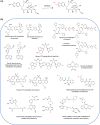Biotransformation: Impact and Application of Metabolism in Drug Discovery
- PMID: 33214818
- PMCID: PMC7667663
- DOI: 10.1021/acsmedchemlett.0c00202
Biotransformation: Impact and Application of Metabolism in Drug Discovery
Abstract
Biotransformation has a huge impact on the efficacy and safety of drugs. Ultimately the effects of metabolism can be the lynchpin in the discovery and development cycle of a new drug. This article discusses the impact and application of biotransformation of drugs by mammalian systems, microorganisms, and recombinant enzymes, covering active and reactive metabolites, the impact of the gut microbiome on metabolism, and how insights gained from biotransformation studies can influence drug design from the combined perspectives of a CRO specializing in a range of biotransformation techniques and pharma biotransformation scientists. We include a commentary on how biology-driven approaches can complement medicinal chemistry strategies in drug optimization and the in vitro and surrogate systems available to explore and exploit biotransformation.
Conflict of interest statement
The authors declare no competing financial interest.
Figures






















Similar articles
-
Microbiota-drug interactions: Impact on metabolism and efficacy of therapeutics.Maturitas. 2018 Jun;112:53-63. doi: 10.1016/j.maturitas.2018.03.012. Epub 2018 Apr 5. Maturitas. 2018. PMID: 29704918 Review.
-
Conventional and novel approaches in generating and characterization of reactive intermediates from drugs/drug candidates.Curr Drug Metab. 2011 May;12(4):383-94. doi: 10.2174/138920011795202974. Curr Drug Metab. 2011. PMID: 21395525 Review.
-
In vitro screening techniques for reactive metabolites for minimizing bioactivation potential in drug discovery.Curr Drug Metab. 2008 Nov;9(9):952-64. doi: 10.2174/138920008786485209. Curr Drug Metab. 2008. PMID: 18991592
-
Microbial biotransformation: a tool for drug designing (Review).Prikl Biokhim Mikrobiol. 2013 Sep-Oct;49(5):435-49. doi: 10.7868/s0555109913050097. Prikl Biokhim Mikrobiol. 2013. PMID: 25474866 Review.
-
Hepatic drug metabolism in cystic fibrosis: recent developments and future directions.Ann Pharmacother. 1993 Jan;27(1):74-9. doi: 10.1177/106002809302700117. Ann Pharmacother. 1993. PMID: 8431626 Review.
Cited by
-
Reviewing a plethora of oxidative-type reactions catalyzed by whole cells of Streptomyces species.RSC Adv. 2022 Mar 1;12(12):6974-7001. doi: 10.1039/d1ra08816e. eCollection 2022 Mar 1. RSC Adv. 2022. PMID: 35424663 Free PMC article. Review.
-
Biotransformation of the Phenolic Constituents from Licorice and Cytotoxicity Evaluation of Their Metabolites.Int J Mol Sci. 2021 Sep 18;22(18):10109. doi: 10.3390/ijms221810109. Int J Mol Sci. 2021. PMID: 34576274 Free PMC article.
-
Development of a New Isoxsuprine Hydrochloride-Based Hydroxylated Compound with Potent Antioxidant and Anti-Inflammatory Activities.J Microbiol Biotechnol. 2024 Dec 28;34(12):2693-2701. doi: 10.4014/jmb.2405.05031. Epub 2024 Oct 3. J Microbiol Biotechnol. 2024. PMID: 39467698 Free PMC article.
-
Electrochemical Simulation of Phase I Hepatic Metabolism of Voriconazole Using a Screen-Printed Iron(II) Phthalocyanine Electrode.Pharmaceutics. 2023 Nov 4;15(11):2586. doi: 10.3390/pharmaceutics15112586. Pharmaceutics. 2023. PMID: 38004565 Free PMC article.
-
Bioremediation of hazardous heavy metals by marine microorganisms: a recent review.Arch Microbiol. 2024 Feb 15;206(3):103. doi: 10.1007/s00203-023-03793-5. Arch Microbiol. 2024. PMID: 38358529 Free PMC article. Review.
References
-
- Safety Testing of Drug Metabolites Guidance for Industry. U.S. Department of Health and Human Services Food and Drug Administration Center for Drug Evaluation and Research (CDER). March 2020. Pharmacology/Toxicology, Revision 2. https://www.fda.gov/media/72279/download (accessed 2020-08-12).
-
- Gu C.; Artelsmair M.; Elmore C. S.; Lewis R. J.; Davis P.; Hall J. E.; Dembofsky B. T.; Christoph G.; Smith M. A.; Chapdelaine M.; Sunzel M. Late-occurring and long-circulating metabolites of GABAAα2,3 receptor modulator AZD7325 involving metabolic cyclization and aromatization: relevance to MIST analysis and application for patient compliance. Drug Metab. Dispos. 2018, 46 (3), 303–315. 10.1124/dmd.117.078873. - DOI - PubMed
LinkOut - more resources
Full Text Sources
Other Literature Sources
Chemical Information

